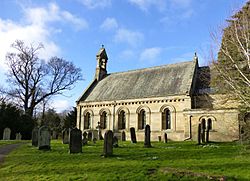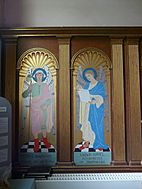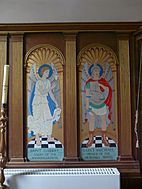St Michael and All Angels Church, Howick facts for kids
Quick facts for kids St Michael's Church |
|
|---|---|
| St Michael and All Angels Church | |
 |
|
| 55°26′59.363″N 1°36′31.093″W / 55.44982306°N 1.60863694°W | |
| Location | Gardens of Howick Hall |
| Country | England |
| Denomination | Church of England |
| History | |
| Status | Parish church |
| Founded | c. 12th century |
| Dedication | Archangel Michael and all the angels |
| Architecture | |
| Functional status | Active |
| Heritage designation | Grade II |
| Designated | 31 December 1969 |
| Architect(s) | FJ Francis |
| Style | Neo-Norman and Romanesque |
| Completed | 1849 |
| Specifications | |
| Materials | Sandstone |
| Administration | |
| Archdeaconry | Northumberland |
| Diocese | Newcastle |
| Province | York |
St Michael and All Angels Church is a special church in the village of Howick, Northumberland, England. It's part of the Church of England, which is the main Christian church in England. This church is found inside the beautiful gardens of Howick Hall. It's also a "Grade II listed building", which means it's an important historical building protected by the government. Lots of people, about twenty thousand each year, come to visit this church!
Contents
History of the Church
The area around Howick has had a church for a very long time. Records show a priest named Asket here in 1158. The first church was built in the Norman style, which was popular in England after 1066.
Changes Over Time
Sadly, the original Norman church was destroyed by a fire in 1746. A new church was built to replace it. This second church was described as an 'Ionic temple', meaning it had columns like those found in ancient Greek buildings. But this building also burned down!
The church you see today was built in 1848. It was designed by an architect named FJ Francis. He chose a neo-Norman style. This means it looks like the old Norman churches, but it was built much later, during the Victorian era. You can see this style in its round-arched Romanesque windows and doors. Francis made the church bigger by adding a chancel (the area around the altar) and a vestry (a room for priests). He also added a bell-cote, which is a small structure for bells.
The Grey Family Connection
The church has a strong connection to the Grey family, who lived at Howick Hall. Many members of the Grey family are buried in the churchyard.
Charles Grey, 2nd Earl Grey
The most famous Grey family member was Charles Grey, 2nd Earl Grey. He was the Prime Minister of the United Kingdom from 1830 to 1834. During his time as Prime Minister, an important law called the Reform Act 1832 was passed. This law helped more people have a say in how the country was run. Today, he is perhaps best known for the special tea that carries his name!
Artistic Contributions
The Grey family didn't just attend church; some of them also helped decorate it. Maria Copley, the 3rd Countess Grey (1803–1879), was a sculptor. She carved the gargoyles that you can see on the outside north wall of the church. Gargoyles are often carved figures that can look a bit scary or funny.
Mabel Palmer, the 5th Countess (1884–1958), asked for the paintings that are behind the altar and near the baptismal font. These paintings show important figures.
See also
 In Spanish: Iglesia de San Miguel y Todos los Ángeles (Howick) para niños
In Spanish: Iglesia de San Miguel y Todos los Ángeles (Howick) para niños



